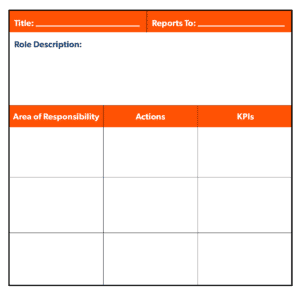One of the silent productivity killers in small and medium businesses, and particularly within family businesses, is a lack of role clarity. That is, people aren’t 100% clear and focused on what their core role is and what success looks like in that role. Unfortunately this means that individuals and teams aren’t as effective as they could and should be, because there’s bleeding and blurriness across roles and business activities.
So what you often get as a result is where there’s team members trying to wear multiple hats, or on the flip side you may have one hat being shared across more than one individual. Neither of these are very effective.
Something that is often overlooked and underestimated is the humble job description. A clear and concise JD that is effectively used can go a long way towards providing role clarity in your business.
A job description should never be more than 1 page, otherwise it’s too complex and likely won’t be any real use. There are 4 basic elements to prepare a simple job description that works.
Title
First up, you need a title. Titles are important, but not in the way that a lot of people think. A title shouldn’t be designed to impress people you come into touch with, so you can ditch the fancy pants job titles. A painter is not a Colour Distribution Technician and a cleaner is not a Sanitation Consultant. Your job title exists to give a team member clarity as to their role and position, nothing more and nothing less. If the role involves co-ordination of the business marketing activities, the title is marketing co-ordinator. Not rocket science.
Who They Report To
Then you need to be clear on who the team member reports to. This should be in terms of a role rather than a name, such as general manager or sales manager. Unclear lines of communication and reporting are another example of role blurriness.
Role Description
Next you need a simple role description, which should be a basic statement that describes the intent of the position. This should be outcome based, so not a description of the tasks per se, but the desired outcomes the role is expected to produce. So for a marketing co-ordinator position, the outcomes may be “To continually improve the business brand exposure within our target market and to provide consistent campaign and lead generation support to the sales department.”
Key Responsibilities
Finally for the meat of the job description, you need to set out the key responsibilities of the role, which is broken up into three sections. Area of Responsibility, Tasks or Actions and Key Performance Indicators.
So the role may be broken up into more than one area of responsibility, for example Social Media, Digital Marketing and Internal Communications. There shouldn’t be an area of responsibility that sits outside the core role. If your marketing co-ordinator happens to help out with HR or purchasing or something else, it should be on a separate job description. And whilst this may seem counter intuitive to my simplicity argument, it will actually help identify inconsistency and inefficiency and give you a chance to fix it.
Each area of responsibility will have some core actions or tasks that need to get done in that area, for instance Social Media may have content generation, social posting and profile management.
Then each area will also have some form of measurement in terms of a KPI – to continue the same example, this could be number of social followers, website click through or some other measure that provides meaning to performance.

And that’s it. A simple one page job description you should be able to fill out in 10 or 15 minutes. Job title, direct report, role description, areas of responsibility, actions and measurement. If you haven’t got effective job descriptions in place across your team, I suggest you get to work.
If you have any questions or would like a template in the this format, please reach out directly, we’d be more than happy to help.
